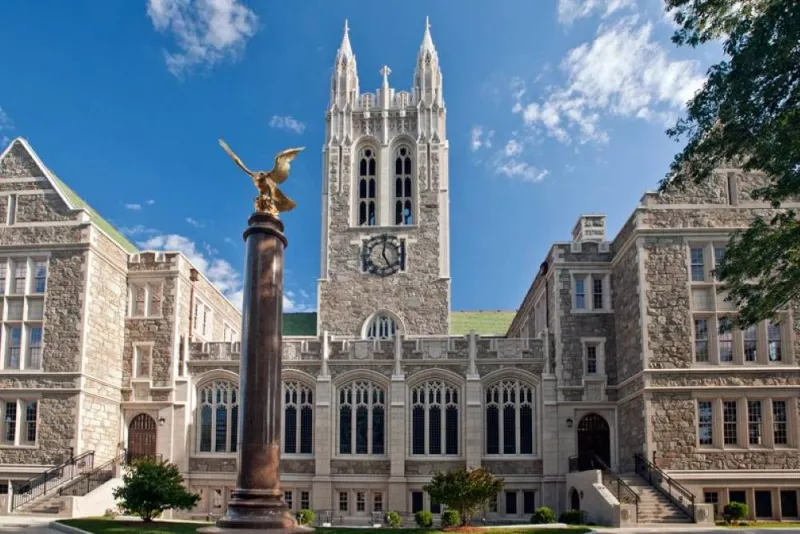In January 2015, Boston College’s Woods College of Advancing Studies launched the Master of Science in Applied Economics degree program; director Dr. Aleksandar (Sasha) Tomic joined the program in May.
Since its first cohort of students enrolled that year, the program has expanded, evolved, and innovated, becoming one of the most groundbreaking applied economics master’s programs available, online or on campus.
What makes the program so distinctive?
“The vision, the team, the curriculum, the support services,” says Dr. Tomic. “Above all, our vision centers on creating an engaged, top-quality, student-focused program grounded in the real world. A market-leading program comes first,” he says. “From this student-centered perspective, everything else follows.”
On Impatience and the Freedom of Starting from Scratch
One issue the team faced at first was “impatience,” Dr. Tomic says. “We wanted to do so many things. But we curtailed our impatience and adopted a methodological approach, focused on creating a program that is responsive to the market.”
Building out the MS in Applied Economics program from scratch presented both challenges and opportunities—but mainly opportunities, Dr. Tomic says, in that it freed the team to focus from day one on building a customized program that is responsive to market needs and, first and foremost, helps students reach their goals.
Every aspect of the program is, and continues to be, specifically designed to reflect the founding vision, Dr. Tomic says.
Real-World Curriculum, Dedicated Faculty
With the nimbleness and drive of a startup, the team developed a “living, breathing” Master’s in Applied Economics curriculum that can respond to market needs–the foundation of the program.
This adaptability is crucial. “The market moves so fast,” says Dr. Tomic, “and we need to stay ahead.”
One of the curriculum’s key tenets is industry-alignment, supported by the program’s advisory board of industry leaders. As its name implies, the MS in Applied Economics program’s strength is its application in the real world.
Of course, a “living, breathing’ curriculum requires the right faculty to deliver it.”
“We are very proud of the fact that (our faculty) are not only incredibly academically qualified,” Tomic says, “but also have the work experience to back it up.”
Five years on, many of the current faculty have been with the program since it began, which shows “their dedication to the program, their dedication to the students,” says Dr. Tomic.
“Bringing together an experienced, dedicated faculty fosters more than an excellent learning environment, as important as that is. It also provides an invaluable opportunity to introduce students to, and engage them in, the way things work in the real world,’” Tomic explains.
Engagement is a cornerstone of the Applied Economics Master’s program, both for and by students. With guidance and mentorship, students learn to engage with the world through a holistic understanding and application of economic principles.
It is no surprise, then, that this feature was the next all-important element in the program’s evolution.
Engagement, Mentoring, and Career Support
A resolute focus on student outcomes grounds the evolution and vision of the Master’s in Applied Economics program. After all, the success of the program hinges on the success of its cohorts.
With the curriculum and faculty in place, integrating first-class, comprehensive student support was paramount. Once again, the freedom to build from scratch was an advantage. “We were able to bring in the resources to formalize that part of the program,” Tomic says.
From the beginning, students had access to Boston College’s Career Center. In addition, the program also employs both strategic and tactical approaches to help students manage their careers, grow their networks, and continue learning.
Whether it is individual support, industry contacts, ongoing mentorship, or career events, the program’s commitment to its students is not a one-off proposition. Comprehensive engagement throughout a student’s journey is “what we do,” says Dr. Tomic. “Not just giving them content, not just talking at them, but engaging them.”
Like the program’s curriculum, student support, engagement, and mentoring are “living, breathing” facets of the program.
The Master’s in Applied Economics Program: Then and Now
In 2015, the first cohort of students enrolled in a 10-course curriculum delivered in an on-the-ground classroom format at Boston College.
Today, in addition to the five core courses, students have 26 elective courses from which to choose. The current hybrid online/ground-based format provides the flexibility students need, offering a single degree program in either modality or a mix of both.
Whether in a physical classroom or online, the focus on student involvement and outcomes remains the same. All courses, online or in-person, are limited to 20 to 25 students “because we want to provide our students engagement with the faculty,” Tomic says. ‘Most importantly, we do not want a cookie-cutter ‘subject matter expert’/ facilitator model, where a subject matter expert develops the course and facilitator(s) are hired to actually conduct it.”
A Peek at the Future
Evolution is an ongoing process. And so it is with the Master of Science in Applied Economics degree program. Dr. Tomic’s vision for its future is best summed up in three words: interaction, integration, connection.
“I see a deep integration and interaction with the various stakeholders,” Dr. Tomic says. “Whether it’s with the advisory board, the faculty, or mentoring students, the key is supporting one another.”
Students can look forward to increased exposure to the “real world” of policy, government, and business. More student/industry interaction through student research or quasi-consulting projects will provide opportunities for students to show off their work. In short, the program will broaden and deepen the scope of how applied economics impacts our modern world.
From the first and each successive cohort, a growing network of practitioners collaborate, share ideas, and apply knowledge to understand and engage in the world.
“Our program is quite unorthodox,” says Dr. Tomic—and the visionary program director plans to keep it that way.
